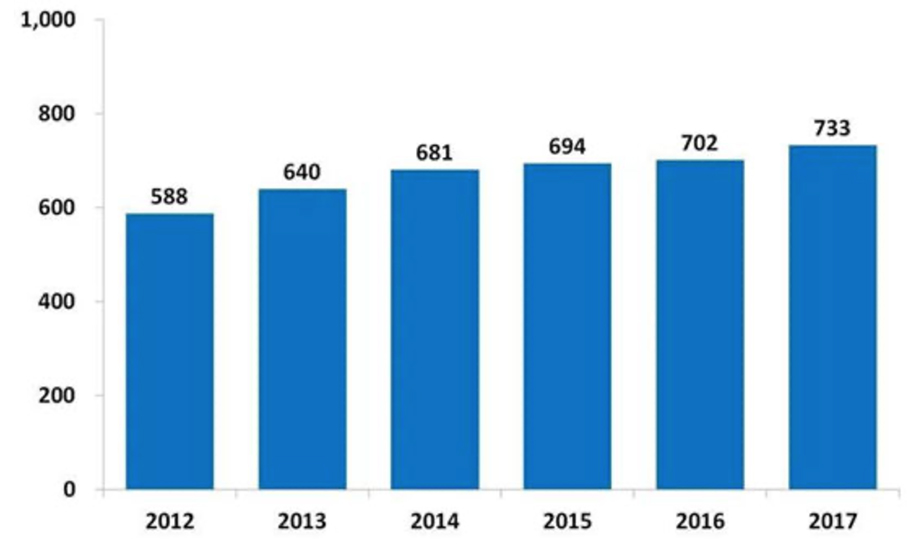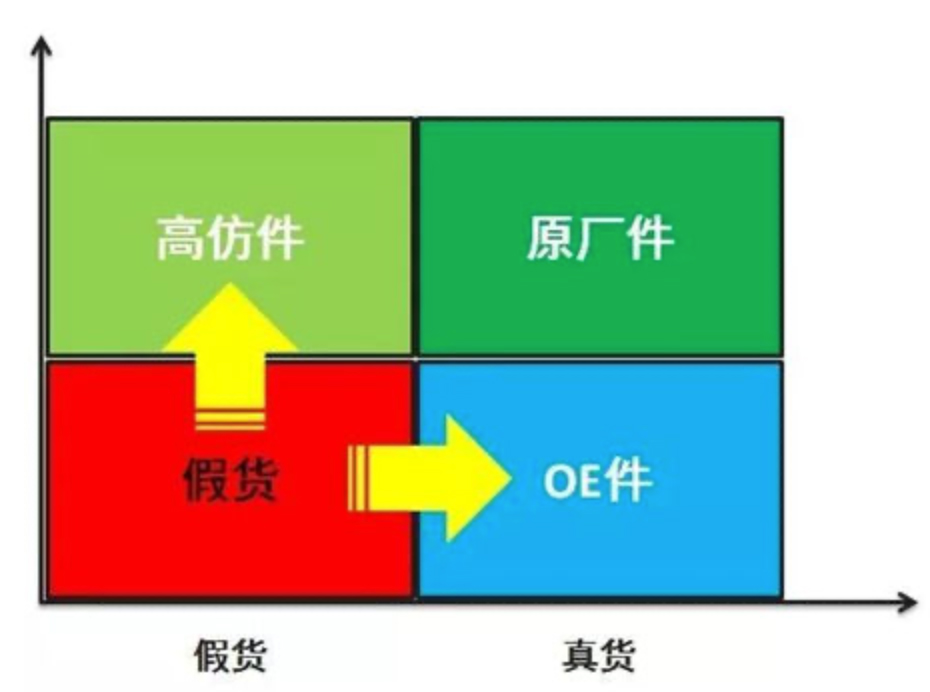With the continuous expansion of China's infrastructure construction, the demand for construction machinery has continued to increase in the past ten years. China has become the world's largest single market for construction machinery and equipment, and the sales and ownership of equipment ranks first in the world. According to the statistics of China Construction Machinery Industry Association, by the end of 2017, the number of main products of construction machinery in China was about 6.9 million to 7.47 million units, which is still on the rise. The development curve is shown in Figure 1 (calculated by the median value)

Figure 1: China's construction machinery and equipment inventory (10000 units)
In recent years, the equipment sales market has been very strong, which has led to equipment manufacturers and agents generally focusing on sales and less on services, and feel that it is difficult to make money from maintenance services. At the same time, brand manufacturers only allow agents to deal in original parts, and are not allowed to do business of sub-factory parts, which also brings excellent development opportunities to parts stores. Agents only provide customers with a choice of original parts, which means they have no choice. The market downturn makes users unbearable for high-priced original parts. More and more users start to use sub-factory parts, and more than 80% of users Buying accessory parts after the warranty period expires, "Made in China" makes domestic parts supporting factories spring up like mushrooms after a rain, the quality is more and more reliable, and the cost is getting lower and lower, which also provides a huge development opportunity for parts stores. It can be said that it is the development of the subsidiary parts and accessories store that has helped many customers through the difficult period of the industry.
Huge equipment holdings have brought hundreds of billions of parts and services to the aftermarket. Manufacturers and agents have realized the importance of the aftermarket. The development of the Internet has also brought new opportunities to the aftermarket. Internet platforms are also emerging one after another, and the competition in the aftermarket will be more intense, all of which will bring new challenges to the development of accessories stores. What is the future of accessories stores? Many owners of accessories stores have doubts about this. The author tries to talk about his views from three aspects.
1. Parts stores must develop in the direction of brand and high quality
Whenever someone mentions an accessory store, someone associates it with "mom and pop shop" and "counterfeit parts". It is true that many accessories stores have developed in the form of mom-and-pop shops, and the quality of the parts they started operating was not reliable, but that was already the old calendar.

Figure 2: Changes in accessories store products
Today's parts stores operate more and more domestic and foreign parts brands (Figure 2). The quality and price of the products can meet the needs of customers at different levels. Many parts are comparable to the original parts, but the prices are more competitive. . Parts stores and agents have different models. The distributors have a wide variety of accessories, and there are thousands of types of parts. However, parts stores only operate a few types of products according to their own advantages, and there are only dozens of types of parts. Product advantages, batch advantages, Multi-brands and price flexibility allow accessories stores to better meet customer needs, and the stock rate of parts is higher; at the same time, many accessories stores are located in the accessories street or in the electromechanical city. It is easy to provide customers with one-stop service to meet the various needs of users for parts.
In the future, accessories stores and accessories associations must vigorously promote their brands, so that accessories stores can completely draw a clear line with fake and shoddy parts, so as to win the trust of more customers and win a larger market share. The accessories association should also actively advocate honest management and eliminate the market for counterfeit parts, which will only ruin the reputation of the accessories store. Guangzhou is the distribution center of China's construction machinery parts market. "Guangzhou is the country's accessories, and Guangzhou's accessories are the Pearl Village." Every year, tens of billions of accessories are sold from Guangzhou to all parts of the country, and even exported to all parts of the world. Guangzhou spare parts market has become a business card of China's construction machinery spare parts market. The effect of this brand depends on the quality and cost-effectiveness of parts, which is worth learning from spare parts stores in other provinces.
2. Parts stores need digital transformation and management upgrades
The author studied and compared the data of the top 50 construction machinery in the world, and found some interesting results: from 2012 to 2016, China was in the top 50, and the scale indicators such as the number of companies on the list, total assets, total employees and sales Shangjun ranks in the top three, but it ranks in the bottom three in terms of efficiency indicators such as per capita sales, profit margin and return on assets! This is almost identical to the situation of Chinese companies in the Fortune 500 in 2018: 120 Chinese companies have entered the world's top 500, ranking the top in the number and scale of companies on the list, but at the bottom of the list in terms of profitability, return on sales and return on equity declining year after year. Enterprise competitiveness is mainly reflected in the efficiency of operation. After the enterprise has passed the period of rapid development, if it does not pay attention to and improve its own operation efficiency, it is difficult to go further by relying only on extensive development, not to mention the century-old store. , Construction machinery parts stores are currently facing such challenges.
In the past, the parts store diverted the parts business of many agents, helping users reduce maintenance costs. In the competition with the agents, the parts store showed the advantages of cost performance and flexibility. However, although many parts stores are doing well, their management is very backward. Bookkeeping and random storage of goods will not have much impact when the scale is small. . When inventory data is required, it is either not available, and even if the data is obtained, the accuracy is poor. There is no electronic inventory data, and each inventory needs to be closed for several days. You must know that a company as big as Walmart has never been closed for inventory! The management level is the key. Through systems such as SAP, the accounts and physical objects can be kept consistent at all times.
Many parts stores are still using paper document management, lacking the invoicing system and electronic data, and only based on electronic data can we gain insight into customer needs, mining customer needs can help us accurately market, and the application of big data can also Help the accessories store plan what, when, and how much to save. For example, if the turnover parts of an agent or accessories store only account for 25% of the total inventory, the application of big data may reduce the inventory amount by about 70%. Scientific inventory management greatly improves the utilization rate of funds and the return on investment. Rate. Therefore, the parts store needs digital transformation and management upgrade, and the first step in the transformation is the EDI (Electronic Data Interchange), so that the boss can keep abreast of the parts store's operation, accounts receivable, inventory turnover and cash flow. . None of this would be possible without electronic data.
At present, although many parts stores are still making money, their profits are declining. Many bosses do not understand the management of spare parts inventory, which leads to an increase in the amount of inventory, a decrease in the turnover rate, and a decrease in profits. A lot of money earned by the spare parts store has turned into inventory and put it in the warehouse. The longer the operation time, the greater the sluggish inventory. Erosion of the profit of the accessories store year after year. The stage of extensive development of the industry has come to an end. Continuing to operate according to the original model may not make any money. In the future, refined management is required to obtain higher returns with less capital.
As an accessory store owner, you have to keep an eye on your inventory because your money is there! So try to answer the following questions: How high is the amount of inventory in your warehouse? What is the ROI for accessories? How high is the spare parts inventory turnover rate? Which of your inventory is good and which is bad? How much is your sluggish inventory? How many types of fast, medium and slow turnover parts are in the warehouse? What are your different inventory strategies for different types of parts? Do you know how expensive it is to carry spare parts inventory? If you can't answer these questions precisely, how do you manage your inventory?
3. Accessories stores need to embrace the Internet in order to acquire more customers
With the development of the Internet, the Internet of Things and big data, the Internet model has higher efficiency and cost advantages in connecting customers. In this case, accessories stores also need to transform to the Internet. Even if you are worried that the Internet may steal your customers and reduce the profit of accessories, you cannot stop the development of Internet platforms. It is undeniable that many customer acquisition and marketing models of the Internet can also be learned and used by accessories stores, which will help us gain more customers. We must see that the demand for parts and services requires high timeliness. No manufacturer or Internet platform can independently build such a warehousing, logistics and distribution network to meet the needs of customers. The only solution is to combine, customers, Technicians (backpackers), repair shops, parts stores, agents and parts suppliers form a construction machinery parts sharing platform. Customers can find their urgently needed parts through their mobile phones anywhere, and the parts store closest to him will become him supplier. The Internet is not to establish a monopoly, but to provide value, make it more convenient for users, and allow accessories stores to increase their business and gain more customers. This is the "Internet model" of the future accessories store business.
The huge equipment inventory of China's construction machinery is a gold mine in the aftermarket. The potential of parts in the aftermarket of excavators alone exceeds 100 billion. Thousands of agents and parts stores can provide customers with fast parts supply, and parts stores are close to the market. , close to the user, the future is still promising. However, the inventory turnover rate of many parts stores is only 2 to 3 times per year, and the sluggish inventory ratio is as high as 30% to 50%. In other words, tens of billions of sluggish inventories are accumulated in the warehouses of dealers and parts stores, which seriously affects their cash flow and profits and increases inventory risks. The Internet can help agents and parts stores optimize inventory turnover and improve operational efficiency.
Post time: Feb-08-2023




